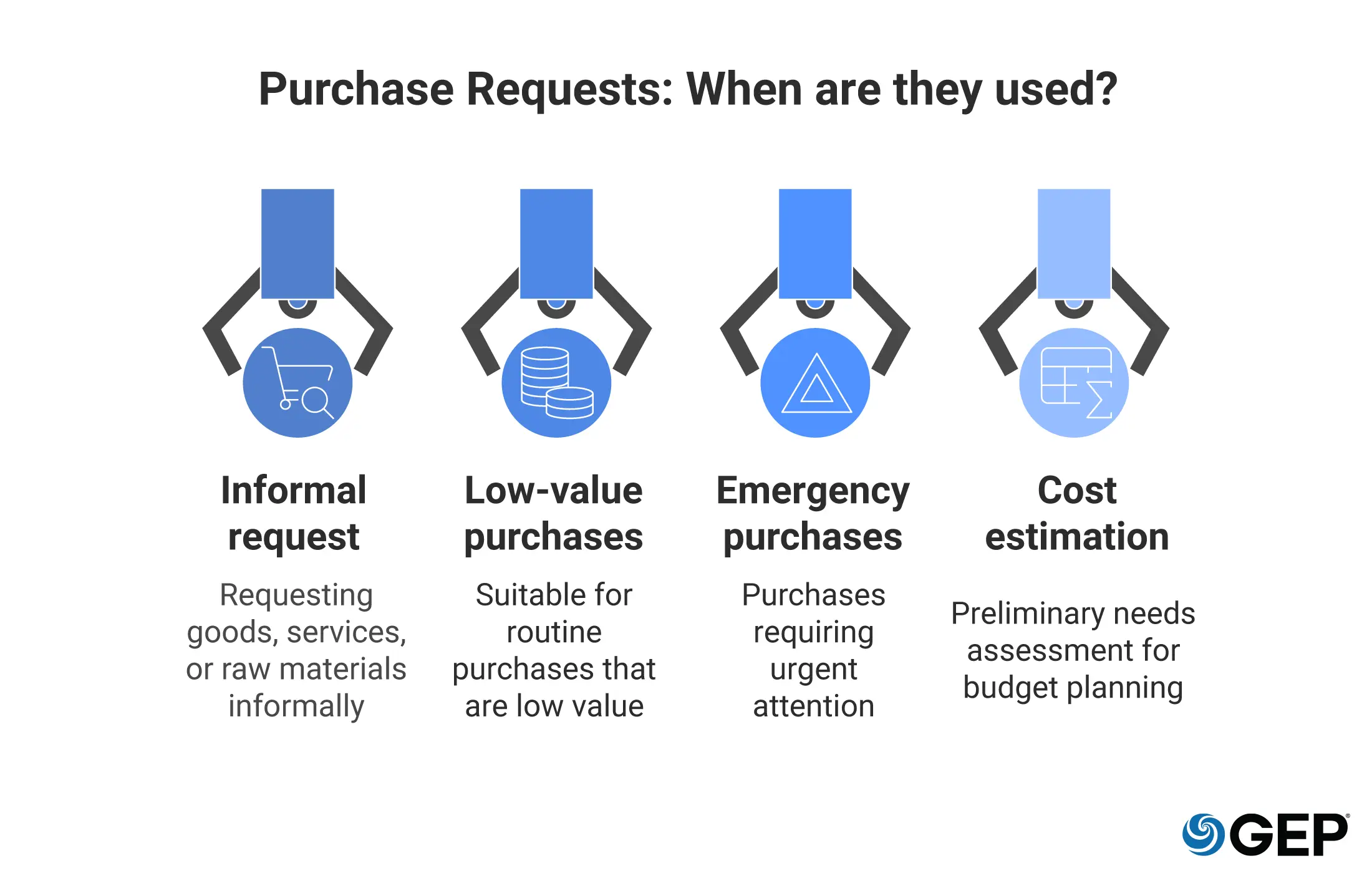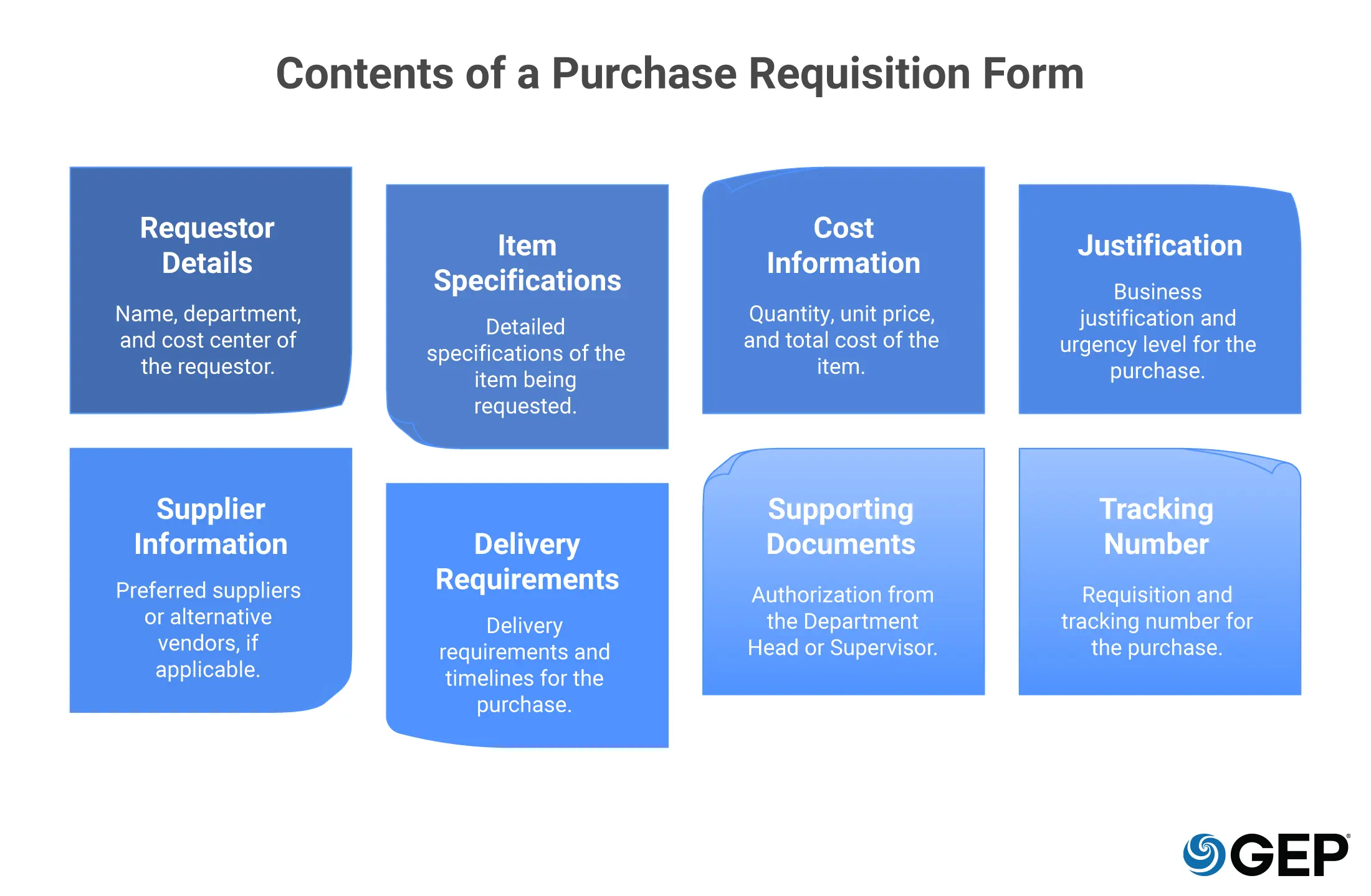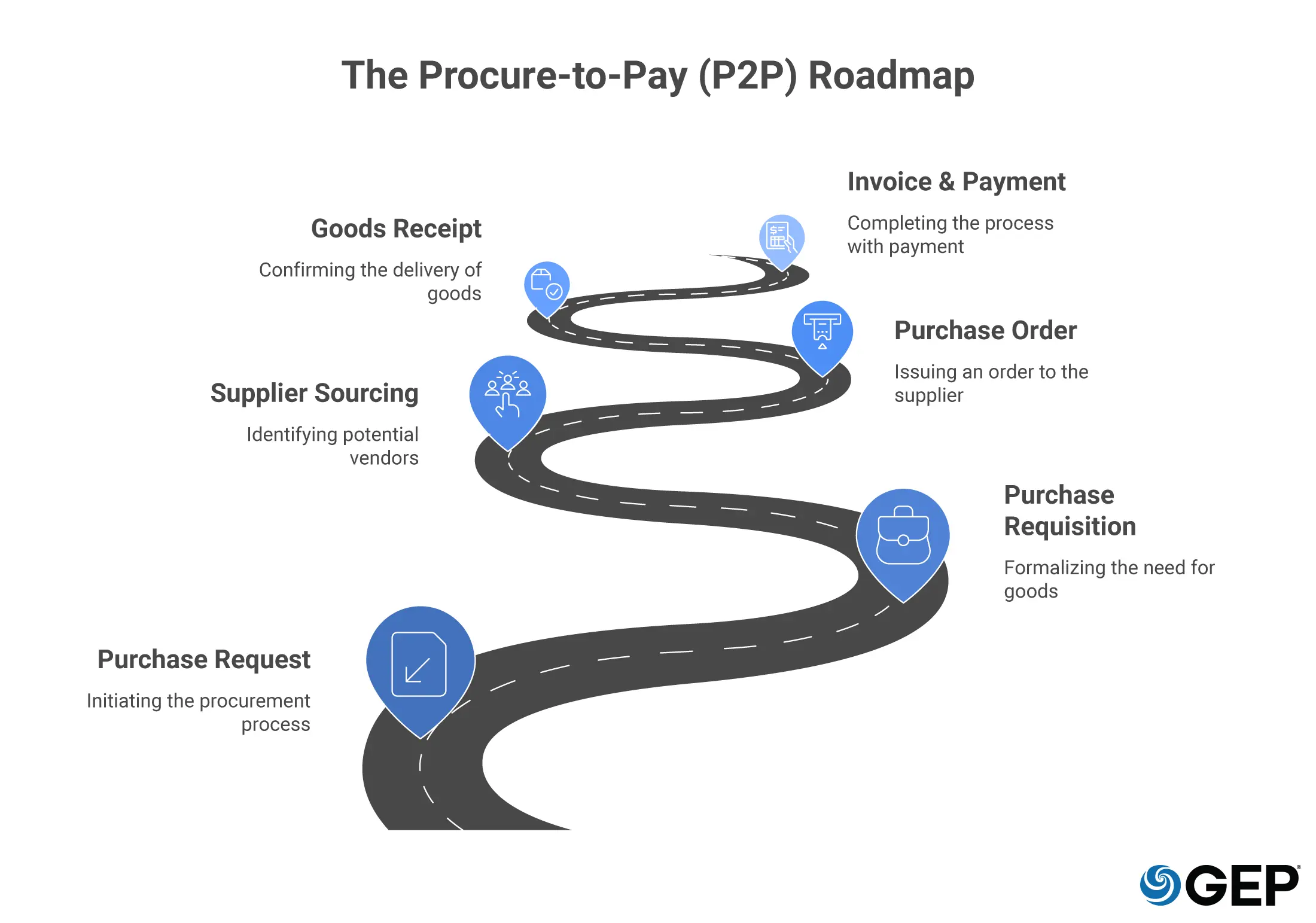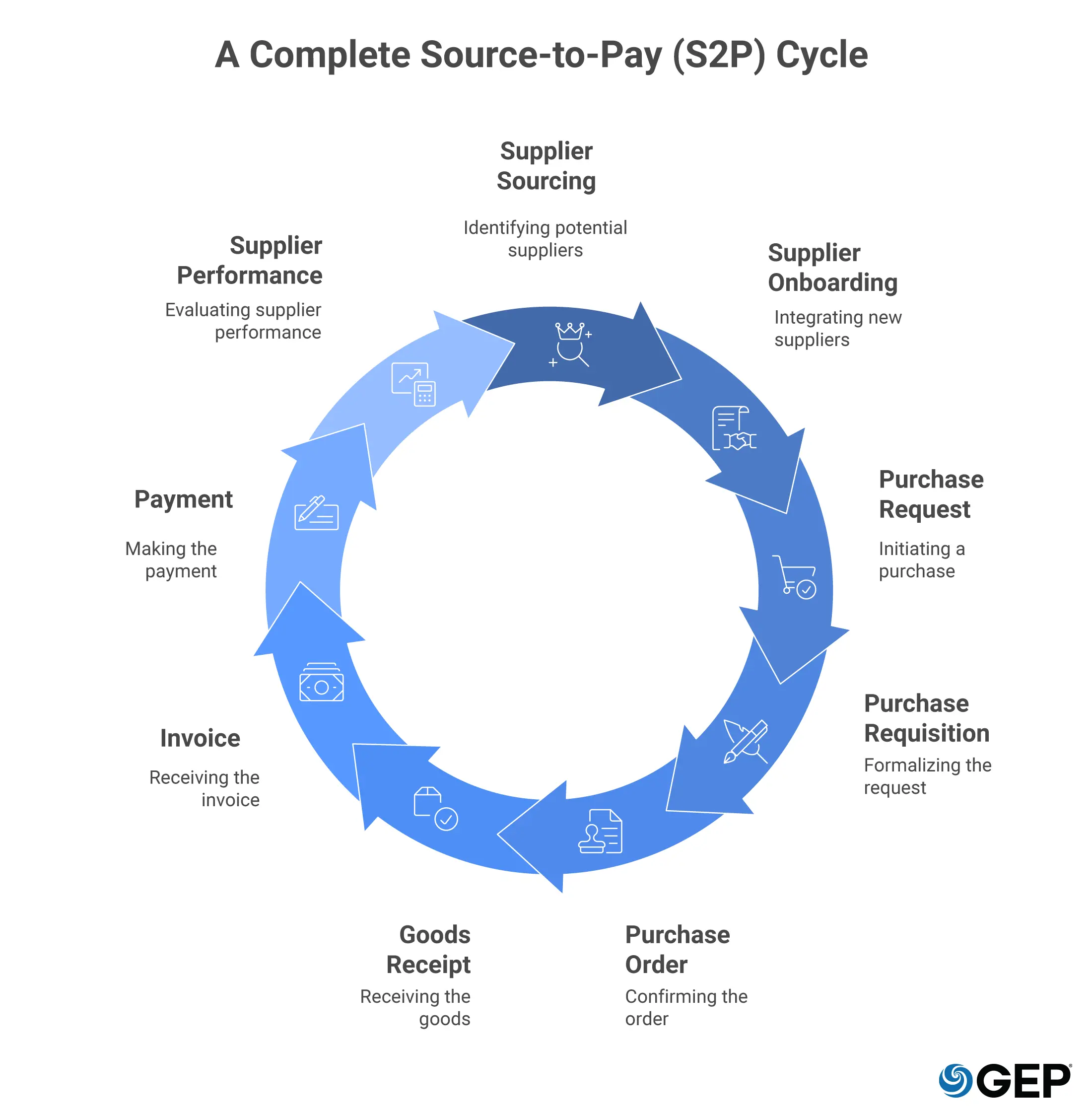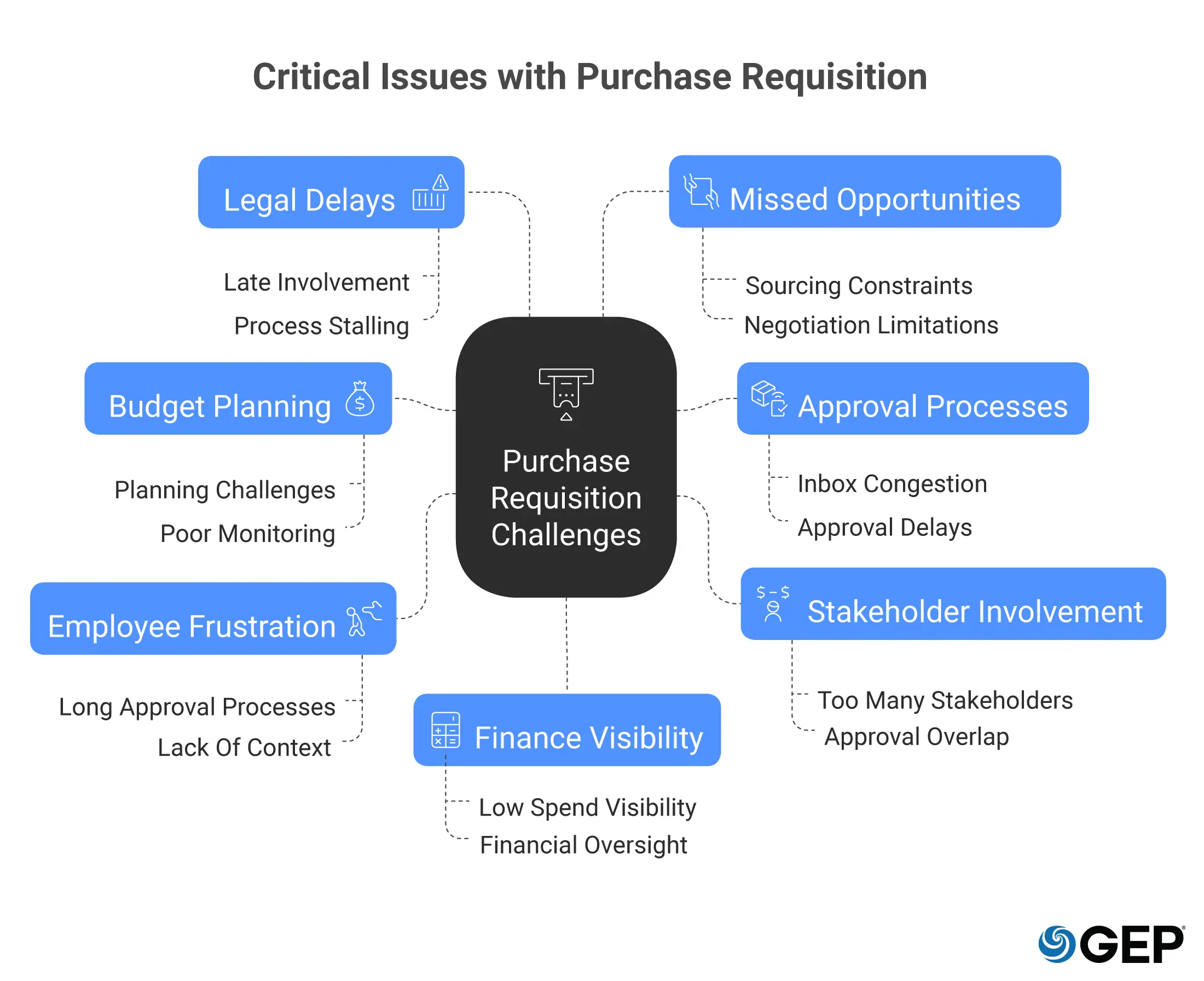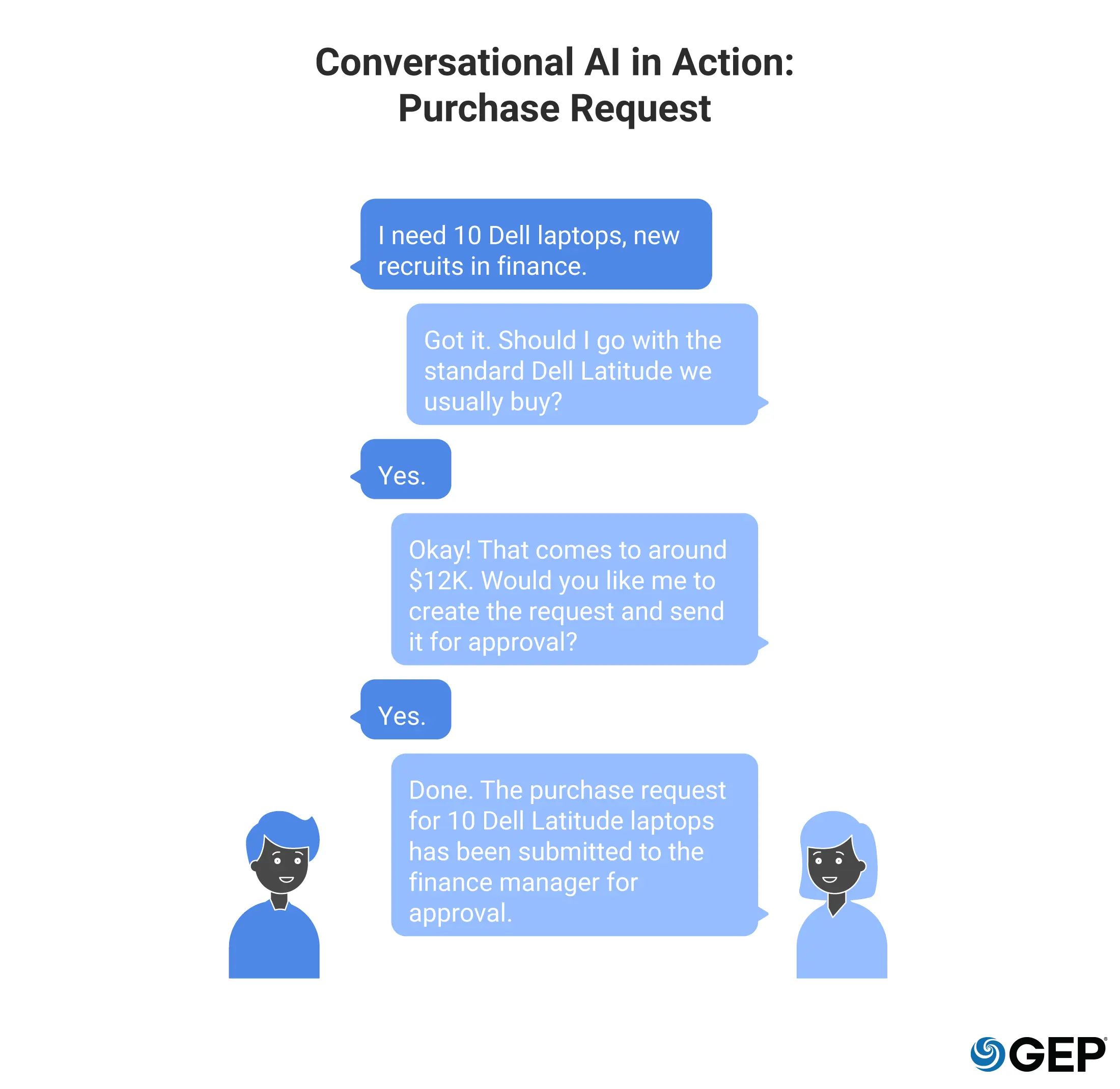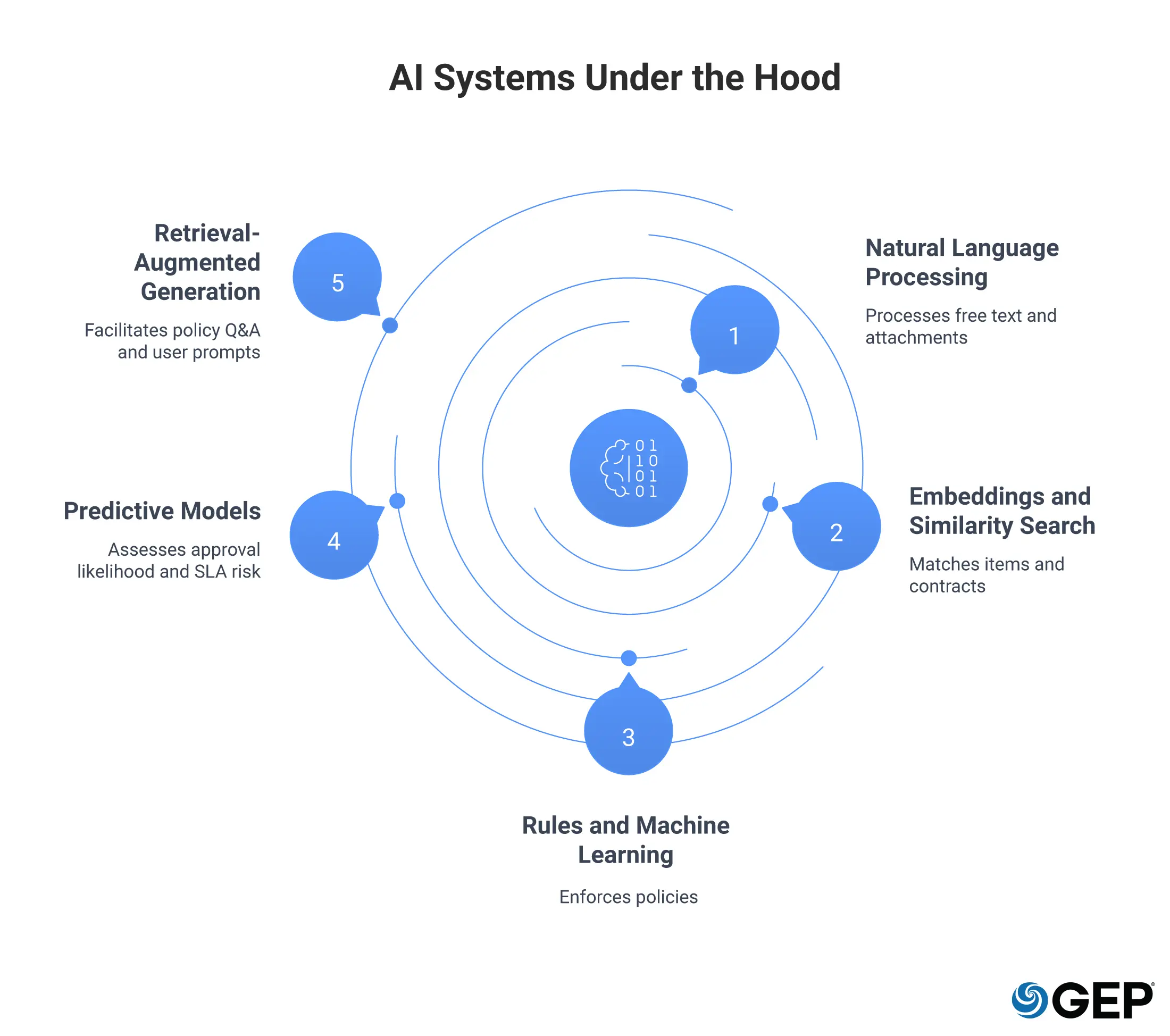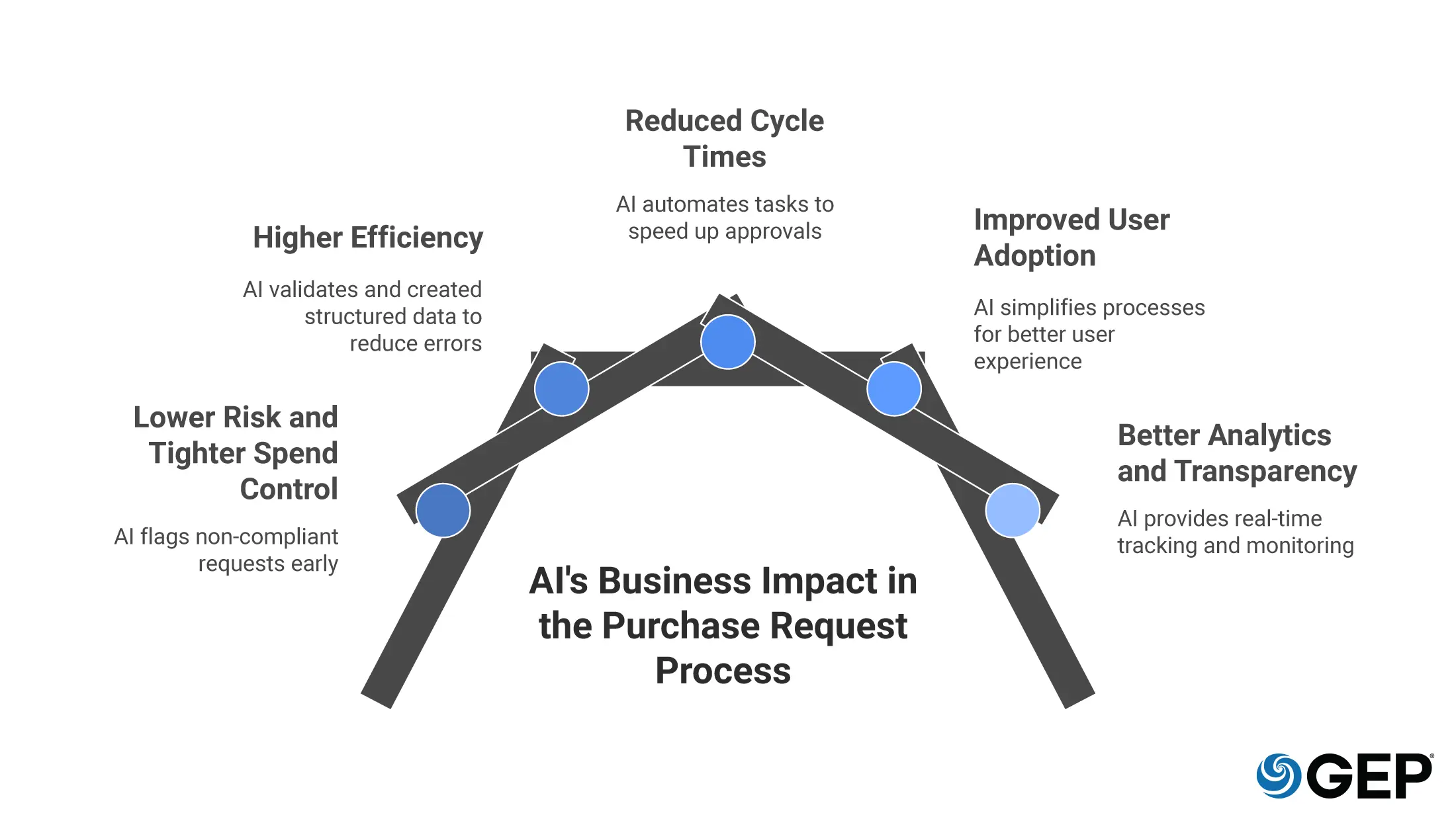
The Secret to Faster S2P Cycles? AI in Purchase Request Processes
- A purchase request is used to express a procurement need, and AI routes it for approval.
- AI validates information before submission to catch errors or policy violations early.
- Conversational AI converts employee chats into structured purchase requisitions.
October 01, 2025 | Source to Pay 8 minutes read
A purchase request is precisely where procurement begins. And it sets the tone for everything that follows. If your process of creating a purchase request is unbearably slow or inaccurate, it will negatively affect all the downstream activities that follow.
This is why procurement leaders around the world are trying to standardize and automate the process for purchase requests using AI.
But before getting into how you can implement AI, it is important to know the difference between purchase requests and purchase requisitions, as the majority use them interchangeably. Recently, most companies have combined the two processes, and we’ll dive into that in a bit.
Purchase Requests vs. Purchase Requisitions
While both processes are similar, they are distinct in their functionalities.
Purchase Requests
Before procurement teams reach out to potential suppliers, they gather sourcing requests from internal and external stakeholders. This makes a purchase request the first step in the procurement process.
A purchase request is an informal document used within organizations when an employee or a department wants to express a procurement need. It usually includes basic information like item description, quantity, estimated cost, and demand justification. The document can be submitted via email, verbal communication, or a simple form, and a formal approval workflow follows.
Purchase Requisition
A purchase requisition is the formal internal record that authorizes a purchase. It documents the need, assigns the budget account, and initiates the procurement workflow. Organizations treat the requisition as the official source for approvals and as a legal document for audit evidence.
A requisition uses predefined fields, so downstream systems don’t need to guess. Procurement accepts a requisition only after required validations and approvals are complete. That acceptance turns a request into an actionable procurement event.
A typical requisition entry includes detailed specifications: item description, exact quantity, unit price or estimate, cost centre/GL code, delivery location, required-by date, justification, and approver routing.
The process requires standardized approval workflows in order to track the status of a purchase requisition and define specific statuses for each stage, like Draft, Submitted, Under Review, Approved, and Converted to PO.
The requests are screened against current inventory or stock levels, budget availability, and compliance with company policies. Once approved, it is then passed on for Purchase Order (PO) creation and external supplier communication.
Talk to our Expert
What Is the Difference Between A Purchase Request and A Purchase Requisition?
A purchase request is the initial, informal request to buy goods or services, which may be submitted via email, form, or directly in an ERP/procurement system. And a purchase requisition, on the other hand, is the formal, standardized document generated in the ERP or procurement software.
Both require approvals and are carried out internally by an individual employee or department within an organization.
Purchase requests are usually used for low-impact items like office supplies and urgent requirements that don’t need a full approval workflow. A purchase requisition is used for high-value items that may be strategic purchases. They go through an extensive series of approvals, like compliance checks, inventory checks, and approvals from finance and other departments.
Every purchase requisition can be a purchase request, but not every purchase request functions as a requisition. The difference lies in the request’s format, approval rules, legal implications, and the requested item’s direct impact on revenue.
Discover More: Purchase Requisition Software System
The Ground Reality
In practice, most companies don’t treat “purchase requests” and “purchase requisitions” as separate processes. Instead, they combine them.
What does it improve? This purchase request process is faster and less confusing. It also reduces the number of duplicate and abandoned requests.
However, large enterprises with heavy compliance still keep them separate. This type of arrangement is common in the public sector, regulated industries, or global corporations with strict policies.
The process begins with a purchase request as a lightweight intake of demand, followed by a purchase requisition process that is refined and ready for documentation.
Whether you choose to combine the two or keep them separated, digitization and implementing AI in the purchase request process can help you save costs and improve efficiency in the purchasing process.
How Purchase Requests Work Without AI (Traditional Workflow)
Traditionally, procurement was seen mainly as Procure-to-Pay (P2P) process.
Purchase Request → Purchase Requisition → Purchase Order → Goods Receipt → Invoice → Payment
This linear approach treats each step as a separate, manual handoff.
Over time, procurement matured into a more strategic function, which gave rise to source-to-pay (S2P) as the broader, modern framework.
Sourcing → Supplier Evaluation & Onboarding → Purchase Request → Purchase Requisition → Purchase Order → Goods Receipt → Invoice → Payment → Supplier Performance Management
The problem with traditional procurement without AI in purchase request processes
When many processes work in parallel, the result often results in ‘a series of unfortunate events.’
The problems are usually hidden in the little details: an incomplete or vague document, manual errors, request duplication, too many stakeholders, and fragmented workflows. These small misses can snowball into a major disaster.
Here’s how it goes:
An employee will make a purchase request through email, phone calls, or basic forms, and that information gets entered into the procurement system. This was done manually for the most part, and then the request would be sent ahead for approvals that usually involve multiple stakeholders and departments.
Approval processes involved manual routing, and both the employee who made the request and the stakeholders may be unaware of its status while it is being handled by other stakeholders.
In other words, inconsistent, incomplete, or incorrect purchase requests were added, visibility was limited, and the whole procurement system was prone to errors. This may ultimately cost the organization millions of dollars and a tainted reputation.
Top Source-to-Pay Software
Find out why Gartner® named GEP a Leader in the 2025 Magic Quadrant™. See how we were evaluated.
How AI Revolutionizes Purchase Request Processing in Procurement
AI targets each of the choke points that procurement teams face with the traditional model using targeted interventions.
Let’s look at what AI can do for optimized S2P cycles in procurement.
Intelligent Intake and Conversational Capture
Logging into an ERP to complete a form wastes time and invites errors. Conversational capture allows employees to either speak or type a simple request, which is then converted into fields that are ready for the ERP system.
The requester doesn’t need to follow a particular format to create a purchase requisition. All they need to do is converse with AI, and it will create a structured (and rather detailed) purchase request.
How it works with conversational AI:
Structured data that the ERP or procurement system can understand:
Field | Details |
|---|---|
| Item | Dell Latitude Laptop |
| Quantity | 10 |
| Cost Estimate | $12,000 |
| Department | Finance |
| Justification | New joiners |
| Requester | Employee ID: 45219 (John Doe) |
| Date/Time | Aug 19, 2025 – 10:32 AM |
| Budget/Cost Center Code | FIN-OPS-2025 |
| Delivery Location | IMTS Chicago HQ – 5th Floor IT Store Room |
| Required By Date | Aug 25, 2025 |
| Preferred Supplier | Dell Technologies |
| Status | Submitted to Manager for Approval |
| Approval Path | Finance Manager → Procurement → IT Ops |
| Priority Level | Normal |
The system can now match it against preferred suppliers, trigger approval workflows, link it to budget codes, and auto-generate a purchase request. The user can also make changes as needed.
Policy Guidance and Real-Time Checks
When a request exceeds policy limits, the system flags it in real time. It recommends compliant options that adhere to budget availability and category rules.
Anomaly and Duplication Detection
Pattern matching catches near-duplicates already in flight. It blocks split orders, odd quantities exceeding predefined limits, and/or wrong input of suppliers that aren’t assigned to a specific item.
Dynamic Approval Routing
Also called Intelligent Approval Routing, it applies predefined rules, then sends alerts and reminders to keep the queue moving. This takes hours out of each cycle.
Smart Recommendations: Supplier and Catalog Steering
If the user is unsure about who their preferred supplier must be or if the selected supplier has a low performance score, then AI suggests items from a list of approved suppliers, complete with real-time pricing and lead times.
Supplier Validation and Conflict of Interest
Personal suppliers do not slip through. The system checks the vendor master, flags conflicts of interest, and scans for shared addresses or repeated favoritism. ISO guidance on anti-bribery maps cleanly to these checks, and all suspicious cases are routed to procurement for review.
Human-in-the-Loop Exception Handling
Exceptions are categorized by urgency and risk. These notifications go to the right buyers and approvers, and they include alerts too. The human invention is still a key factor and applies where it matters: nonstandard items, bad suppliers, and high or maverick spending. Everything else runs straight through.
Business Impact Tied to AI in Purchase Request Processes
Reduced Cycle Times
Intelligent routing, reminders, and escalations keep approvals moving. Data entry and validations run automatically. In practice, large teams report shorter request-to-PO times once intake is structured.
More Efficiency and Fewer Errors
Historical trends guide budgeting, sourcing, and supplier choice. AI also asks requesters for missing details before submission and creates structured data, reducing the chances of errors and request rejections.
Lower Risk and Tighter Spend Control
Instead of relying on approvers to catch non-compliance, AI can apply policy logic at submission time and flag spending above thresholds, steer to preferred suppliers, enforce budget limits, and reduce maverick spending before it happens.
Improves User Experience and Adoption
By auto-suggesting existing contracts, supplier catalogs, or framework agreements, AI helps employees reduce the chances of choosing wrongly, and requesters become more willing to follow the official process rather than bypass it.
It is also easy to use and gives users a break from routine tasks by auto-completing forms, offering guided support, creating structured purchase requests, and sending approvers timely automated alerts, increasing productivity and user adoption.
Better Data Analytics and Increased Transparency
Every request has a visible trail and is stored in the cloud as it happens, giving finance and audit teams a complete record without extra effort. Employees and relevant stakeholders can access well-organized dashboards that help them track the status of every request made across the S2P cycle in real time.
The company, on the other hand, collects essential data that can help them further optimize their processes and digital stack.
Conclusion
AI fixes and standardizes the first mile. It turns a plain sentence into clean fields, selects approved items, applies contract pricing, and routes to the right approver. You can trust it to drive change, guide without intruding, and default to known preferences when something seems off.
Ready to take the next step?
GEP SMART™ is a cloud-based source-to-pay software. See how it standardizes purchase requests at the source and shortens cycle times. Request a demo today.
FAQs
AI in the purchase request process speeds up the approvals even before a request is submitted. It verifies the information shared by the requester at submission and catches errors or policy violations early on. This move in itself significantly decreases the cycle time. Next, AI passes on the request to the right set of people via an intelligent routing process based on predefined rules and waits. If the approver is taking too long to respond, or if the request needs verification, AI will escalate it ahead, accordingly.
Yes. AI checks requests against budgets, supplier lists, and category rules at the time of submission. It auto-fills missing details, flags duplicate or unusual entries and classifies free text into the right codes. Over time, learning models improve accuracy by drawing from past approvals and corrections.
